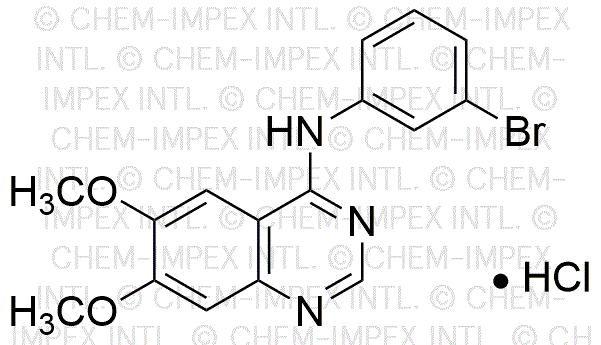PD 153035 Hydrochloride is widely utilized in research focused on:
- Cancer Research: This compound acts as a selective inhibitor of certain receptor tyrosine kinases, making it valuable for studying tumor growth and progression in various cancer types.
- Neuroscience: It is used to investigate the role of specific signaling pathways in neuronal function, helping researchers understand neurodegenerative diseases.
- Pharmacology: PD 153035 Hydrochloride is employed in drug development studies to evaluate its efficacy and safety as a potential therapeutic agent.
- Cell Biology: This compound aids in elucidating cell signaling mechanisms, providing insights into cellular responses to external stimuli.
- Biotechnology: It is applied in the development of targeted therapies, offering a pathway for creating more effective treatments with fewer side effects compared to traditional chemotherapy.
General Information
Properties
Safety and Regulations
Applications
PD 153035 Hydrochloride is widely utilized in research focused on:
- Cancer Research: This compound acts as a selective inhibitor of certain receptor tyrosine kinases, making it valuable for studying tumor growth and progression in various cancer types.
- Neuroscience: It is used to investigate the role of specific signaling pathways in neuronal function, helping researchers understand neurodegenerative diseases.
- Pharmacology: PD 153035 Hydrochloride is employed in drug development studies to evaluate its efficacy and safety as a potential therapeutic agent.
- Cell Biology: This compound aids in elucidating cell signaling mechanisms, providing insights into cellular responses to external stimuli.
- Biotechnology: It is applied in the development of targeted therapies, offering a pathway for creating more effective treatments with fewer side effects compared to traditional chemotherapy.
Documents
Safety Data Sheets (SDS)
The SDS provides comprehensive safety information on handling, storage, and disposal of the product.
Product Specification (PS)
The PS provides a comprehensive breakdown of the product’s properties, including chemical composition, physical state, purity, and storage requirements. It also details acceptable quality ranges and the product's intended applications.
Certificates of Analysis (COA)
Search for Certificates of Analysis (COA) by entering the products Lot Number. Lot and Batch Numbers can be found on a product’s label following the words ‘Lot’ or ‘Batch’.
*Catalog Number
*Lot Number
Certificates Of Origin (COO)
This COO confirms the country where the product was manufactured, and also details the materials and components used in it and whether it is derived from natural, synthetic, or other specific sources. This certificate may be required for customs, trade, and regulatory compliance.
*Catalog Number
*Lot Number
Safety Data Sheets (SDS)
The SDS provides comprehensive safety information on handling, storage, and disposal of the product.
DownloadProduct Specification (PS)
The PS provides a comprehensive breakdown of the product’s properties, including chemical composition, physical state, purity, and storage requirements. It also details acceptable quality ranges and the product's intended applications.
DownloadCertificates of Analysis (COA)
Search for Certificates of Analysis (COA) by entering the products Lot Number. Lot and Batch Numbers can be found on a product’s label following the words ‘Lot’ or ‘Batch’.
*Catalog Number
*Lot Number
Certificates Of Origin (COO)
This COO confirms the country where the product was manufactured, and also details the materials and components used in it and whether it is derived from natural, synthetic, or other specific sources. This certificate may be required for customs, trade, and regulatory compliance.


